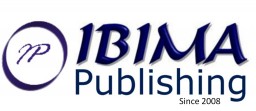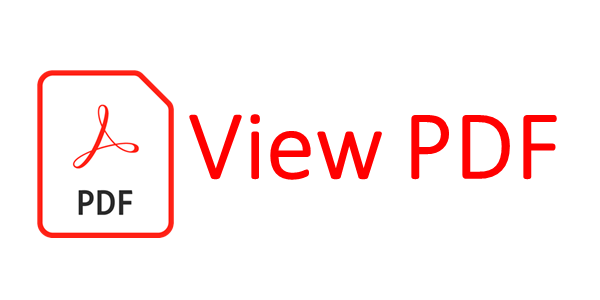Introduction
Printing has played a key role in the dissemination of knowledge and information for centuries. However, not all printing techniques are equally accessible to people with visual impairments. This article focuses on the evolution of printing techniques dedicated to this group of people, analyzing both historical and contemporary solutions. The aim of the work is to examine how modern printing technologies, such as UV and flexographic printing, affect the improvement of information accessibility and quality of life of blind and visually impaired people.
People with visual impairments, including nearly 2 million people in Poland, for whom Braille is a basic communication tool, face numerous barriers in accessing visual information. Lack of access to appropriately adapted printed materials hinders their independent functioning, education, work and participation in social life. The growing demand for printed materials tailored to their needs poses new challenges for printing technology. That is why it is so important to develop and implement printing technologies that meet the specific needs of this group of people. This article aims to fill the gap in the literature by identifying and evaluating the impact of modern printing techniques on the accessibility of information for people with visual impairments.
As part of the research, a literature review and an analysis of available printing technologies were carried out, with particular emphasis on their application in the production of tactile materials. The focus was on identifying key technologies, such as UV and flexographic printing, and assessing their potential in the context of the needs of people with visual impairments.
The beginnings of typographic art can be traced back to Johannes Gutenberg whose achievements include creating the first industrial printing method in the world. When the era of printing began, the creators were aware that it was a unique invention (Juda M., 2017, p. 14). It is worth emphasizing that the invention of typography contributed to the dynamic development of the media revolution (Góralska M., 2012, pp. 20-54).
In search of the origins of printing, one can reach back to a much more distant past than the 15th century and Gutenberg’s discoveries. Numerous prints of human hands found on the walls of French caves date back to approximately 15,000 B.C. (Cave and Ayad, 2015). In what is now Turkey around 6500-6000 B.C., bas-reliefs made of burnt clay were found. Also in ancient Greece and Rome it was common to use stamps with letters, numbers or monograms (Pirożyński, 2002, p. 14). In the 7th century A.D., we can already talk about printing books. The oldest surviving copy of a printed book is considered to be The Diamond Sutra, which is currently kept in the British Museum in London (The Diamond Sutra, 2016). According to Juda, the printing technique has undoubtedly increased the communication possibilities inherent in writing. First of all, it enabled the production of large numbers of identical texts. Lowering the costs of producing printed materials resulted in the spread of reading and writing skills in society in the long run, and the expansion of the circle of readers was not only a quantitative change, but also resulted in a change in the communication system (Juda, 2017, p. 32).
The creation of the offset machine (1904), which allowed for flat printing, was a breakthrough in the evolution of printing techniques. The offset machine was used mainly for printing newspapers, magazines and leaflets. Offset printing, however, had a serious drawback, namely “fixed costs that must be incurred to prepare the document printing process (e.g. a book, folder, business card). These include the costs of film exposure, matrix preparation, the so-called costs of printing machine equipment and high personnel costs. Also a variable unit price that decreases as the number of copies printed grows is the consequence of fixed costs” (Januszko-Szakiel, 2005, p. 51).
The offset printing method has been replaced by the currently dominant digital printing technology. This technique involves printing an image created in a digital device based on materials provided for printing in the form of computer data. A significant advantage of digital printing compared to offset printing is a significant reduction in costs, which are constant regardless of the volume. If a ready, properly prepared digital version of the document is delivered to the printing house, no additional costs related to the preparation of the printing process are incurred (Januszko-Szakiel, 2005, pp. 51-52).
Simultaneously with the progress in the field of printing technology, the possibilities of adapting the emerging solutions to people with visual impairments were considered. People with visual disabilities include blind and visually impaired people (Matczak, 2018, p. 20). It is believed that technological advances in the field of printing have opened up new opportunities to improve the accessibility of education, information and services among people with visual impairments. Adaptation of printing techniques, taking into account the specific needs and limitations of vision, has increased the independence of people with visual impairments. As printing techniques such as flexographic, digital and UV printing have evolved, their use in the context of people with visual impairments has been considered. Initially, printing techniques were used to create books, magazines and brochures, and then overprints on the packaging of medicines, products and other information materials for people with visual impairments. The adaptation of print was a key step in ensuring equal access to information for all social groups and contributed to the improvement of the quality of life of people with visual impairments.
Printing Techniques and their Applications
Printing techniques can be divided into classic (analog) printing techniques and digital printing techniques (fig. 1). The printing process itself is a process of multiple reproduction (duplication) of information (illustrations, graphics or text), which involves applying a coloring material (paint) to a printing substrate using an image carrier (e.g. a printing plate). In the case of classic printing techniques, the image carrier is the printing form, while in digital printing techniques, the carrier is a digital file (Khadzhynova and Jakucewicz, 2016, p. 8). The classic printing techniques include convex printing (typography, flexography, typo-offset), flat printing (offset), intaglio printing (rotogravure, steel engraving, pad printing) and screen printing. The division of printing methods, including classic and digital printing, is shown in Figure 1.
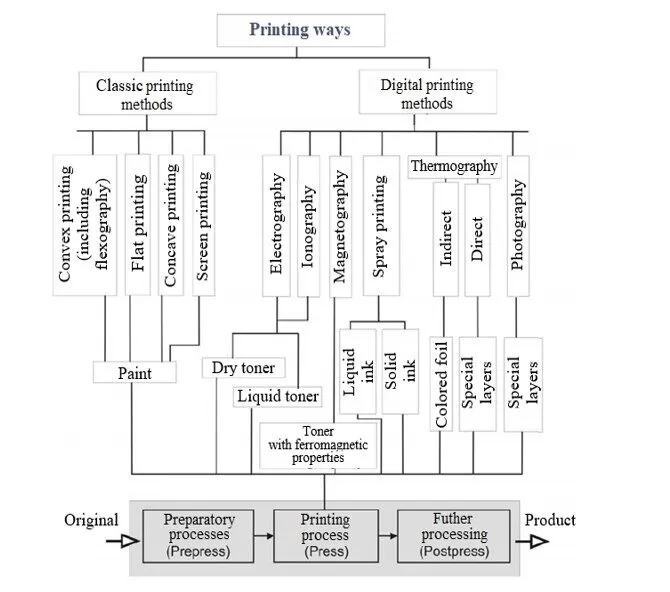
Figure 1. Classification of printing methods.
Source: Authors’ own study based on Kipphan H., Handbuch der Printmedien., Springer-Verlag, Berlin, Heidelberg 2001, p. 42.
Both digital printing and offset printing are widely used today. However, one should pay attention to the positive and negative aspects of each of the printing techniques discussed. Table 1 shows a comparison of digital printing with offset printing. In the case of offset printing, high print quality or fixed costs that are spread over the entire print run can be considered advantages. The disadvantages of offset printing are the need to create a mold. Hence, offset printing is profitable for high volumes (over 1,000 pieces) and unprofitable for low volumes. The advantages of digital printing include short printing time and no need to create a printing plate, which gives a low cost with print runs of less than 1,000 pieces. In turn, the disadvantages include unprofitability for quantities exceeding 1,000 pieces compared to offset printing.
Table 1. Comparison of digital and offset printing
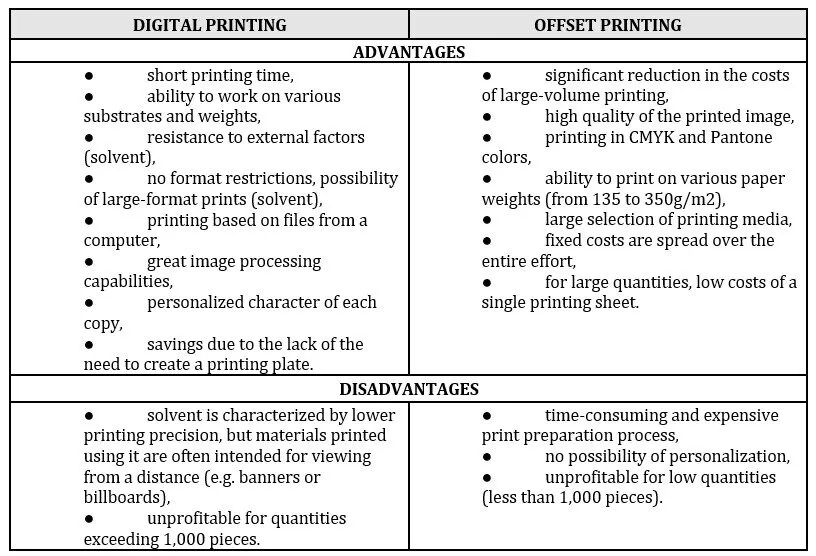 Source: Authors’ own study based on Drukarnia Cyfrowa Cyfro-Druk, http://www.cyfro-druk.eu/cyfro/index.php/17-nowosci/116-druk-cyfrowy-i-offsetowy-wady-i-zalety, (18.05.2024).
Source: Authors’ own study based on Drukarnia Cyfrowa Cyfro-Druk, http://www.cyfro-druk.eu/cyfro/index.php/17-nowosci/116-druk-cyfrowy-i-offsetowy-wady-i-zalety, (18.05.2024).
From the perspective of the aim of the paper related to the adaptation of printing techniques to the needs of people with visual impairments, it is worth paying special attention to two more printing techniques. One of them is intaglio printing, where the printing elements are located below the non-printing elements. This technique consists in the fact that “after applying the paint to the printing form, it is scraped off (using a collecting knife, the so-called squeegee) from the non-printing elements. The ink moves directly from the printing plate to the paper during pressure, and this is how the print is created (Kuciński, 2014)”. The detailed dimension of the concave printing technique is shown in Figure 2.
 Figure 2. Concave printing.
Figure 2. Concave printing.
Source: Authors’ own study based on Kuciński A., Techniki drukowania, op. cit., Bielsko-Biała 2014.
Convex printing, characterized by a relief printing form, is interesting due to the possibility of printing available to people with visual impairments. In this case, the printing elements are placed above the non-printing elements. When applying printing ink to the printing form, “the ink is applied only to the surface of the convex (printing) elements. Direct contact of the inked form with the paper while applying pressure causes the transfer of ink. Convex printing is used industrially as flexography” (Kuciński, 2014). The principle of relief printing is shown in Figure 3.
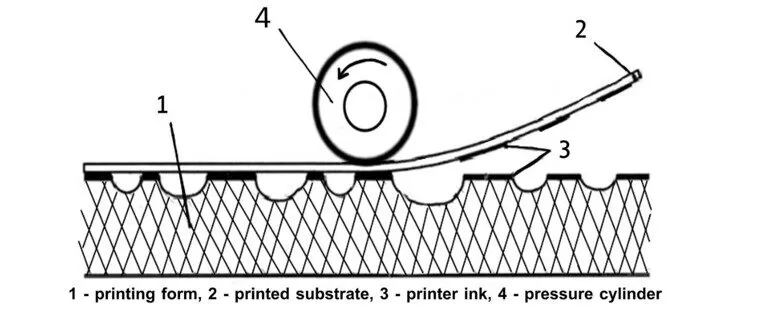 Figure 3. Convex printing.
Figure 3. Convex printing.
Source: Authors’ own study based on Kuciński A., Techniki drukowania, op. cit., Bielsko-Biała 2014.
Concave and convex printing techniques are used in the production of banknotes, among other things, to counteract counterfeiting. At the same time, thanks to the use of these techniques, people with visual impairments can recognize the denomination by touch since banknotes do not have a perfectly flat surface. In the production of banknotes, steel engraving is often used, which gives the impression of convexity, felt when touched with the fingertips (Polska Wytwórnia Papierów Wartościowych). This type of printing is often used to create the main banknote drawings and markings for people who are blind or have vision problems. The convex effect is achieved by applying a thick layer of paint. There are techniques available in space that imitate steel engraving relief, such as:
- the paper surface puncturing,
- pressing appropriate elements,
- applying a transparent layer to various elements,
- applying a loosening powder to the surface of the still wet print (Konarowska, 2011, p. 153).
Techniques that imitate steel engraving are often the so-called dry seals that leave a three-dimensional impression or swelling paints (Nowak et al, 2010, pp.107-109).
Special printing techniques have been widely used in the production of banknotes. Circular means of payment, as a still widely used method of payment, should also be fully accessible to people with visual impairments. The latest series of the Swiss franc, which for years has been considered the best secured and most innovative currency in the world, is an example of banknotes that perform this function well. The Swiss National Bank regularly modernizes banknotes by introducing innovative solutions (Myśliwiec, 2020). The latest, ninth series of banknotes is easier to identify and contains a number of innovations in appearance, security features and CHF denominations (fig. 4). The banknote’s security features include, among others: watermark (fig. 4B), tilt effect (fig. 4D and 4E), microtext (fig. 4F) or Microperf® (fig. 4C). In addition, the banknote has convex prints (fig. 4B), such as the denomination, the name of the bank, and a different symbol for each denomination (in the case of the 100 CHF denomination, hands are visible on the obverse). The banknotes also feature elements in the form of short, convex lines along the long edges of the banknote (fig. 4A), intended to make it easier for people with visual impairments to recognize the denomination. Convex elements will leave traces of color when rubbed against a light sheet of paper (Swiss National Bank).
 Figure 4. Selected security features of the Swiss franc based on
Figure 4. Selected security features of the Swiss franc based on
the example of the denomination of CHF 100.
Source: Authors’ own study based on Swiss National Bank, New banknotes for Switzerland, https://www.snb.ch/en/the-snb/mandates-goals/cash/new-banknotes/security-concept, (18.05.2024).
Machines used for flexographic printing most often have structures that are adapted to the substrate fed from a roll. Flexographic machines can be divided according to various criteria:
- due to the shape of the printing substrate:
- coil (from roll to roll, from roll to sheet),
- sheet-fed,
- due to the location of the pressure cylinder,
- multi-cylinder (series, tower),
- with a central cylinder,
- due to the type of paint,
- water flexography,
- UV flexography,
- solvent flexography.
Flexography is also used in printing on packaging made of foil of various thicknesses, plastic and aluminum, and is also used for printing press, books, labels, clothes and folding cartons. It can also be used in the production of special clothing, T-shirts and credit cards. It is worth adding that flexography also works well for printing on biodegradable plastic films, and both solvent-based and water-based inks are used here (Izdebska, 2012, p. 215.). An important advantage of flexography is its use on biodegradable plastics. Taking into account the increasing amount of plastic production (Figure 5) and the trend towards the introduction of biodegradable plastics, the use of flexographic printing can contribute to a decrease in the amount of waste (Stachurek, 2012, p. 106).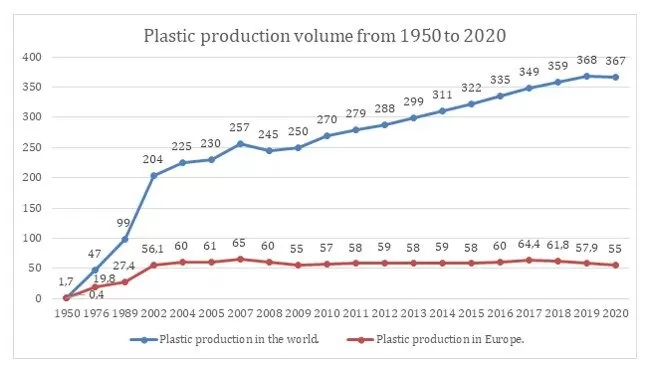
Figure 5. Plastic production in millions of tons in the world and in Europe.
Source: Own study based on annual reports Plastics – the Facts (from 2013 r. to 2021 r.), Plastics Europe Association of Plastics Manufacturers (production volume).
Flexography and UV printing as tools supporting people with visual impairments
According to various estimates, the share of people with disabilities in the structure of society ranges from several to several percent. According to the report “We see not only with our eyes” prepared by the Typhlological Institute of the Polish Association of the Blind, the number of disabled people in Poland is 8.1 million, including approximately 20% with visual impairments (Polski Związek Niewidomych, 2020a, p. 8).
People with disabilities, and in particular people who experience blindness and poor vision due to their conditions, struggle with many socio-financial consequences, including:
- social isolation,
- dependence on others,
- very low level of professional activity,
- using social assistance benefits,
- performing work below the level of capabilities and education (Polski Związek Niewidomych, 2020a, p. 9).
Due to the fact that vision plays a dominant role in the cognition of reality and communication, “congenital damage to this sense significantly hinders or limits the quick and effective implementation of many tasks, especially in areas such as: obtaining information through observation and through written and graphic materials, spatial orientation and independent movement, performing everyday activities” (Czerwińska and Piskorska, 2018, p. 187).
Blind people often use Braille to communicate with their surroundings. The Braille alphabet is based on a system of six convex dots – dots arranged in a rectangular shape in two columns of three dots each. In this way, 63 different configurations can be developed to create single characters (Dimitrova-Radojichikj and Smilkovska, 2013, p. 588). Nowadays, thanks to the progress of printing technology, people with visual impairments have gained an excellent opportunity to develop, learn and explore the world. Thanks to flexography, they can read calendars, leaflets, scientific and popular literature, and also find inscriptions on medicines and labels (Trojnar and Tereszkiewicz, 2023, p. 235). Braille printing devices are widely available. One of the first devices to appear in Poland was the Mountbatten Brailler printer that could “print in six- and eight-point mode. The device is intuitive, the user receives real-time information about an incorrectly entered command, low battery level, etc. via a special tone system. The user-friendly interface has been extended by introducing additional commands for cyclical repetition of printer operations. Communication between a blind user and sighted people is enabled by a liquid crystal display connected to Mountbatten” (Jakubowski, 2012).
Braille plays a key role in facilitating the daily functioning of people with visual impairments. It has also become the main tool facilitating communication between these people in public space. A good practice is the common use of messages in Braille to mark floors, compartments in trains, seat numbers in public facilities, as well as marking rooms (fig. 6). It is recommended to place texts written in Braille in natural places, e.g. on handrails (fig. 7), elevator panels, above door handles, which makes it easier for people with visual impairments to use them freely (Przybyszewski, 2021). The rule is to place room signs in Braille at a height of approximately 150 cm (Kowalski, 2017, p. 55). The Act of July 19, 2019, on ensuring accessibility for persons with special needs, requires public entities to “provide information on the layout of rooms in the building, at least visually, tactilely or audibly” (Act of July 19, 2019, on ensuring accessibility for persons with special needs). Examples of markings in Braille are shown in figures 6 and 7.
 Figure 6. Signs on doors with prints in Braille
Figure 6. Signs on doors with prints in Braille
Source: Authors’ own study based on Emedco, Standard Braille Signs – Provide building information for the visually impaired, https://www.emedco.com/signs/interior-office/ada-braille/standard-braille-signs.html, (18.05.2024).
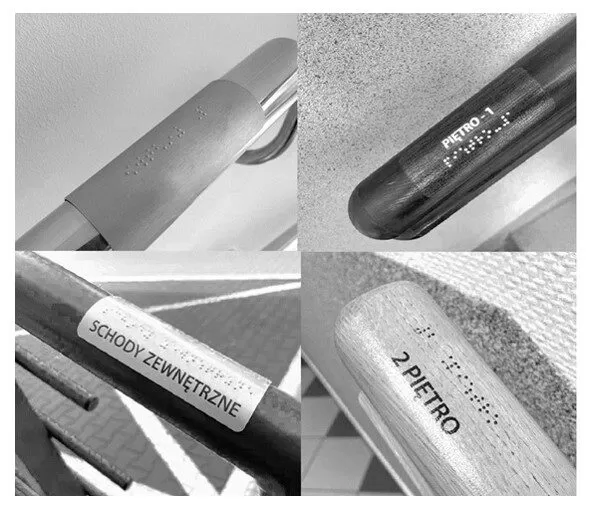
Figure 7. Prints in Braille on: aluminum overlay on the handrail, metal overlay on the external handrail, stickers on the wooden handrail
Source: Authors’ own study based on Znakowanie.info, Nakładki, naklejki, tabliczki na poręcze z alfabetem Brajla, https://znakowanie.info/nakladki-na-porecze-z-alfabetem-braillea/, (18.05.2024).
In the face of contemporary challenges related to public safety, including consumer and product protection, it is necessary to make every effort to provide consumers with full information about the product and the possible effects of its use (Trojnar and Tereszkiewicz, 2023, p. 243.). The above rule contributed to the introduction of the obligation to place messages in Braille on medicinal products. Directive 2004/27/EC of the European Parliament and of the Council of 31 March 2004 clearly states that “The name of the medicinal product as defined in Article 54 lit. (a) must also be expressed on the packaging in Braille. The marketing authorization holder shall ensure that the package leaflet is available at the request of patient organizations in a format appropriate for blind and partially sighted people” (Directive 2004/27/EC of the European Parliament and of the Council of 31 March 2004 – Article 56a). And Article 54 letter (a) is “the name of the medicinal product, followed by information on the strength of the medicinal product and the pharmaceutical form and, if appropriate, whether the product is intended for infants, children or adults; where the product contains up to three active substances, the international non-proprietary name (INN) or, if no such name exists, the common customary name;” (Directive 2004/27/EC of the European Parliament and of the Council of 31 March 2004 – Article 54a).
The regulations indicate that together with the name of the medicinal product printed in Braille (fig. 8, line A), information about the strength of the product (fig. 8, line B) should also be provided to enable people with visual impairments to distinguish medicinal products. The exception is a product that comes in only one strength variant. It should also be emphasized that the entities in charge may also include other information about products in Braille, such as the form of the drug, intended use of the drug, expiry date, etc. Figure 8 shows the packaging of a medicinal product with prints in Braille made using the embossing method.
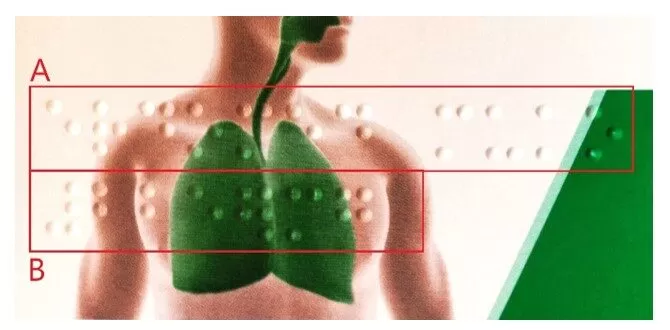
Figure 8. Medicinal product packaging with Braille prints.
Source: Authors’ own study
It is extremely important that the necessary information about the medicine in Braille appears on the outer packaging, usually in the form of a box, even if it is printed directly on the product packaging, such as blisters or bottles. Pharmaceutical companies can voluntarily include their name in Braille on all parts of their packaging. However, it is not recommended to apply labels in Braille on request at the point of sale due to the risk of incorrect labeling and confusion. The text in Braille should be legible and placed in a place that is easy to read, and in the case of distribution of the medicine under parallel import, the same text in Braille should be available in the language of the country of destination to avoid confusion (Polski Związek Niewidomych, 2015).
The key issue is the selection of the appropriate method of embossing dot lettering. There are several methods, such as traditional mechanical embossing on cardboard through a dot matrix, flexographic printing with thickening ink, and mechanical embossing on adhesive tape. The primary goal is to ensure legible text on packaging, and this in turn depends on several factors, such as the parameters of the Braille point, the type of paper used for printing, and the printing technology. The final effect should be verified by a blind person (Polski Związek Niewidomych, 2020b).
Kreiter points out the need to place labels in Braille on food packaging. Food products, classified as first-order needs, should also be available to blind people, which would contribute to a significant increase in their independence and quality of life (Kreiter, 2022).
One of the modern technologies that can significantly facilitate the everyday functioning of people with visual impairments is UV printing. The first studies on the use of UV printing to reproduce Braille on self-adhesive labels of commercial products have already been carried out. The results of these studies clearly indicate that it is possible to obtain high-quality and legible Braille using UV printing (Miloš et al. 2021, p. 5). Figure 9 shows the materials on which UV printing can be used.
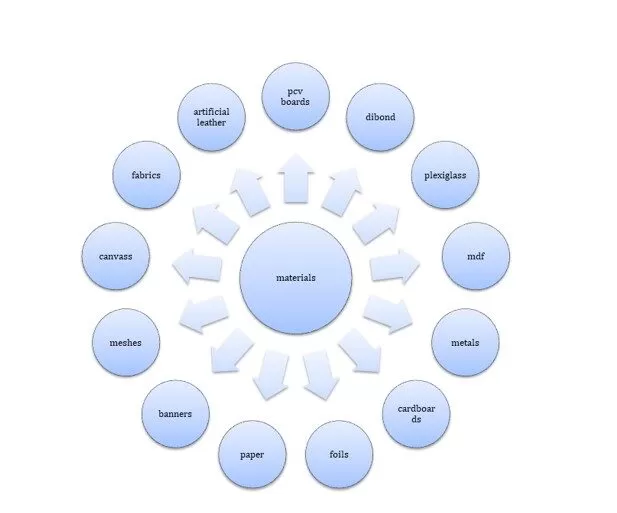 Figure 9. Materials for UV printing.
Figure 9. Materials for UV printing.
Source: Authors’ own study based on UV-druk, Co to jest Druk UV?
https://uv-druk.pl/co-to-jest-druk-uv/, (18.05.2024).
UV printing uses inks with a specific type of liquid polymers, which, under the influence of ultraviolet light from LED lamps installed at the print heads, remain on the surface of the material in the form of a thin layer of colorful and durable plastic. The print is immediately dry and ready for use and further processing. One of the people who used UV printing technology for the benefit of blind and visually impaired people was K. Banaszkiewicz-Badura. She contributed to the creation of illustrated books for the blind. Banaszkiewicz-Badura said in the Świat Druku magazine: “None of the known, available technologies for creating typhlography could reflect my idea: I wanted there to be a lot of illustrations, to be colorful, and the protrusions to be varied. I wanted 100% of the visual information to have a tactile counterpart. I was looking for solutions among printing technologies, in the finishing industry, even in 3D printing. I heard “it’s impossible” dozens of times. UV printing turned out to be a salvation” (Scorpio, 2020).
UV printing opens up opportunities for blind people as consumers, significantly increasing their independence in everyday life. The use of Braille prints on foil packaging of food products is particularly important for visually impaired people, as it enables them to use these products easily and independently. UV printing does not cause the same problems as traditional Braille prints and allows for more information to be included in a less invasive way on the packaging (Trojnar and Tereszkiewicz, 2023, p. 243). For example, the use of Braille labels on food packaging would enable blind people to independently identify and select products by providing details such as ingredients, nutritional values, and expiration dates, which are crucial for dietary management and safety. The presence of Braille labels allows blind people to distinguish between different brands and types of products. Medicines in pharmacies have their names and strengths marked in Braille, which ensures that patients can independently manage their medication schedule and dosage, preventing potential errors that could arise from misidentification. UV printing can also be used to mark public spaces, enabling visually impaired people to access information boards, route markings, and other information posted in public facilities, which contributes to improving their mobility. The use of Braille signs significantly contributes to improving accessibility for visually impaired people, enabling them to move independently and use urban infrastructure. UV printing has a wide range of material applications, which creates unlimited possibilities in the context of printing appropriate markings on products in stores, constituting another element of communication with visually impaired people.
UV printing technology extends its benefits to marking public spaces as well. It enables the creation of accessible information boards in public institutions, such as libraries and hospitals, where blind individuals can access schedules, directories, and informational notices. Tactile route markings at train stations and airports, printed using UV technology, guide visually impaired travelers through the premises, ensuring their safe and confident navigation. The versatility of UV printing across a wide range of materials further enhances its potential in creating accessible environments. This technology enables the production of detailed tactile maps for parks and museums, allowing blind visitors to fully explore and appreciate these spaces. In essence, UV printing not only bridges the gap in information accessibility but also empowers blind individuals to lead more independent and safe lives.
Conclusions
The evolution of printing techniques has significantly contributed to improving the quality of life, independence, and opportunities for people with visual impairments. Modern printing technologies, such as UV and flexographic printing, enable the production of durable and legible Braille materials, which is crucial for the daily functioning, education, and professional development of this group. These advancements align with the findings of other researchers (Miloš et al. 2021, Kreiter 2022), who also emphasize the importance of adapting printing technologies to the needs of people with visual impairments. The use of UV printing in the production of Braille on self-adhesive labels of commercial products confirms the possibility of obtaining high-quality and legible Braille using this technology.
This article presents new information on the practical application of UV and flexographic printing in the production of accessible materials for people with visual impairments. Examples of applications include Braille markings on drug packaging, food packaging, public space signage, and illustrated books for the blind. This demonstrates the versatility of these technologies and their potential to improve the daily lives of people with visual impairments in various aspects, including consumer activities and independent living.
This analysis is based on a literature review and may not take into account all aspects of the use of printing techniques for people with visual impairments. Further research, including case studies and surveys among people with visual impairments, is needed to fully understand their needs and expectations regarding printed materials. Additionally, the economic and organizational aspects related to the implementation of these technologies in various sectors need to be examined.
Further research should focus on assessing the effectiveness of various printing techniques in the context of the needs of people with visual impairments. It is also important to examine the economic and organizational aspects related to the implementation of these technologies in various sectors. In addition, research could focus on developing new printing materials and technologies that are even better suited to the needs of people with visual impairments, such as the use of 3D printing and structural printing.
References
- Cave, R., Ayad, S. and Romkowska, E. (2015) Historia książki: od glinianych tabliczek po e-booki. Warszawa: Wydawnictwo Arkady.
- Czerwińska, K. and Piskorska, A. (2018) ‘Niewidzenie a kompetencje pragmatyczne w komunikacji’, Interdyscyplinarne Konteksty Pedagogiki Specjalnej, (21), pp. 189–210. Available at: https://doi.org/10.14746/ikps.2018.21.10.
- Dimitrova Radojichikj, D. and Smilkovska, D. (2013) ‘Using of the Braille alphabet in the Republic of Macedonia’, in. IV International conference: Modern aspects of special education and rehabilitation of persons with disabilities, Ohrid, Macedonia: Faculty of Philosophy, Skopje, pp. 587–595. Available at: https://repository.ukim.mk:443/handle/20.500.12188/8847 (Accessed: 18 May 2024).
- Directive 2004/27/EC of the European Parliament and of the Council of 31 March 2004 amending Directive 2001/83/EC on the Community code relating to medicinal products for human use (Text with EEA relevance) (2004) OJ L. Available at: http://data.europa.eu/eli/dir/2004/27/oj/eng (Accessed: 18 May 2024).
- Drukarnia Cyfrowa Cyfro-Druk (no date) Druk cyfrowy i offsetowy – wady i zalety. Available at: http://www.cyfro-druk.eu/cyfro/index.php/17-nowosci/116-druk-cyfrowy-i-offsetowy-wady-i-zalety (Accessed: 18 May 2024).
- Emedco (no date) Standardowe znaki Braille’a | Emedco. Available at: https://www.emedco.com/signs/interior-office/ada-braille/standard-braille-signs.html (Accessed: 18 May 2024).
- Góralska, M. (2012) Piśmienność i rewolucja cyfrowa, Biblioteka Jagiellońska, A 400834 II 3454. Wydawnictwo Uniwersytetu Wrocławskiego. Available at: https://jbc.bj.uj.edu.pl/dlibra/publication/351245/edition/335441 (Accessed: 18 May 2024).
- Izdebska, J.E. (2012) ‘Ocena jakości nadruku fleksograficznego na wybranych foliach biodegradowalnych’, in J. Jakubowski and J. Wątroba (eds) Zastosowania metod statystycznych w badaniach naukowych IV. Kraków: Wydawnictwo StatSoft Polska.
- Jakubowski, S. (2012) ‘Komputerowe metody przetwarzania i drukowania tekstów brajlowskich’, Tyfloświat, 3(16). Available at: https://tyfloswiat.pl/czasopismo/tyfloswiat-3-2012/komputerowe-metody-przetwarzania-i-drukowania-tekstow-brajlowskich-dr-stanislaw-jakubowski/ (Accessed: 18 May 2024).
- Januszko-Szakiel, A. (2005) ‘Print on Demand: cyfrowa technologia druku na żądanie jako uzupełnienie tradycyjnej technologii offsetowej’, Przegląd biblioteczny, 73(1), pp. 48–56.
- Juda, M. (2017) ‘Kultura druku i jej wpływ na zmiany cywilizacyjne’, Folia Bibliologica, 58, pp. 13–34. Available at: https://doi.org/10.17951/fb.2016.58.13.
- Khadzhynova, S. and Jakucewicz, S. (2016) Sposoby drukowania cyfrowego. Wydawnictwo Politechniki Łódzkiej. Available at: http://hdl.handle.net/11652/1341 (Accessed: 18 May 2024).
- Kipphan, H. (2000) Handbuch der Printmedien: Technologien und Produktionsverfahren. Berlin Heidelberg. Available at: https://doi.org/10.1007/978-3-642-57024-7.
- Konarowska, U. (2011) ‘Efektywność zabezpieczeń banknotów’, Przegląd Bezpieczeństwa Wewnętrznego, 5(3). Available at: https://journals.indexcopernicus.com/publication/1246026/Urszula-Konarowska-Efektywność-zabezpieczeń-banknotów (Accessed: 18 May 2024).
- Kowalski, K. (2017) WŁĄCZNIK – projektowanie bez barier. Warszawa: Fundacja Integracja.
- Kreiter, M. (2022) ‘Inclusion Movement Increasingly Apparent in Food Packaging’, The Food Institute, 4 January. Available at: https://foodinstitute.com/focus/inclusion-movement-increasingly-apparent-in-food-packaging/ (Accessed: 18 May 2024).
- Kuciński, A. (2014) Techniki drukowania, Bielska Szkoła Przemysłowa. Available at: http://www.bsp.bielsko.pl/wp-content/uploads/2014/09/ctg_kl_1_03_tech_drukowania.pdf (Accessed: 18 May 2024).
- Matczak, T. (2018) Jak żyć… z niepełnosprawnością narządu wzroku. Edited by A. Sprycha. Warszawa: Zakład Ubezpieczeń Społecznych.
- Miloš, S., Vujčić, Đ. and Majnarić, I. (2021) ‘Use and analysis of UV varnish printed braille information on commercial packaging products’, Journal of Graphic Engineering and Design, 12(4), pp. 5–15. Available at: https://doi.org/10.24867/JGED-2021-4-005.
- Myśliwiec, M. (2020) Frank szwajcarski. Bezsprzecznie najbezpieczniejsza waluta świata? Historia, ciekawostki, fakty na temat franka. Wszystkie banknoty i monety CHF, https://www.fxmag.pl. Available at: https://www.fxmag.pl/waluty/frank-szwajcarski-bezsprzecznie-najbezpieczniejsza-waluta-swiata-historia-ciekawostki-fakty-na-temat-franka-wszystkie-banknoty-i-monety-chf (Accessed: 18 May 2024).
- Nowak, A., Malczyk, T. and Nestorowicz, R. (2010) Zwalczanie fałszerstw pieniędzy. Wydawnictwo Wyższej Szkoły Policjiw Szczytnie. Available at: https://biblioteka.wsb.poznan.pl/3663100177919/nowak-aleksandra/zwalczanie-falszerstw-pieniedzy?internalNav=1&bibFilter=366&_lang=en (Accessed: 18 May 2024).
- Pirożyński, J. (2002) Johannes Gutenberg i początki ery druku. Warszawa: Wydawnictwo Naukowe PWN.
- Polska Wytwórnia Papierów Wartościowych (no date) Zabezpieczenia banknotów, PL. Available at: http://www.pwpw.pl/Strefa_wiedzy/Zabezpieczenia_banknotow.html (Accessed: 18 May 2024).
- Polski Związek Niewidomych (2015) Wytyczne Komisji Europejskiej dotyczące wymagań w zakresie informacji na opakowaniu oraz ulotki umieszczonej wewnątrz opakowania (Art. 56a, Dyrektywa 2004/27/EC – braille), Polski Związek Niewidomych. Available at: https://pzn.org.pl/wytyczne-komisji-europejskiej-dotyczace-wymagan-w-zakresie-informacji-na-opakowaniu-oraz-ulotki-umieszczonej-wewnatrz-opakowania-art-56a-dyrektywa-200427ec-braille/ (Accessed: 18 May 2024).
- Polski Związek Niewidomych (2020a) Widzimy nie tylko oczami. Warszawa. Available at: https://pzn.org.pl/wp-content/uploads/2020/12/Raport-Widzimy-nie-tylko-oczam.pdf (Accessed: 18 May 2024).
- Polski Związek Niewidomych (2020b) Zasady Polskiego Związku Niewidomych dotyczące napisów w brajlu na opakowaniach leków, Polski Związek Niewidomych. Available at: https://pzn.org.pl/stanowisko-polskiego-zwiazku-niewidomych-w-sprawie-napisow-w-brajlu-na-opakowaniach-lekow/ (Accessed: 18 May 2024).
- Przybyszewski, T. (2021) ABC Dostępności: A jak Alfabet Braille’a, niepełnosprawni.pl. Available at: https://www.niepelnosprawni.pl/ledge/x/1969607 (Accessed: 18 May 2024).
- SCORPIO (2020) Druk strukturalny dla wsparcia i rozwoju osób niewidomych, SCORPIO Sp. z o.o. Available at: https://www.scorpio.com.pl/pl/druk-strukturalny-dla-wsparcia-i-rozwoju-osob-niewidomych (Accessed: 18 May 2024).
- Stachurek, I. (2012) ‘Problemy z biodegradacją tworzyw sztucznych w środowisku’, Zeszyty Naukowe Wyższej Szkoły Zarządzania Ochroną Pracy w Katowicach, Nr 1(8), pp. 71–108.
- Swiss National Bank (no date) New banknotes for Switzerland. Available at: https://www.snb.ch/en/the-snb/mandates-goals/cash/new-banknotes/new-banknotes (Accessed: 18 May 2024).
- The Diamond Sutra (2016) ‘Learn About the Diamond Sutra’, Diamond Sutra – A New Translation of the Classic Buddhist Text, 13 February. Available at: https://diamond-sutra.com/background-of-the-diamond-sutra/ (Accessed: 18 May 2024).
- Trojnar, K. and Tereszkiewicz, K. (2023) ‘Ocena użyteczności pisma Braille’a w kontekscie poprawy dostępności informacji, zapewnienia bezpieczeństwa i zaspokojenia potrzeb komunikacyjnych konsumentów z dysfunkcją wzroku’, Polityka i Społeczeństwo, 21(2), pp. 232–244. Available at: https://doi.org/10.15584/polispol.2023.2.15.
- Ustawa z dnia 19 lipca 2019 r. o zapewnianiu dostępności osobom ze szczególnymi potrzebami (2019). Available at: https://isap.sejm.gov.pl/isap.nsf/DocDetails.xsp?id=WDU20190001696 (Accessed: 18 May 2024).
- UV-druk (2016) ‘Co to jest Druk UV ?’, Druk UV – nadruk na mdf, hdf, pcv, szkle i plexi – Kraków, 26 February. Available at: https://uv-druk.pl/co-to-jest-druk-uv/ (Accessed: 18 May 2024).
- info (2022) ‘Nakładki, naklejki na poręcze z alfabetem Brajla’, 15 April. Available at: https://znakowanie.info/nakladki-na-porecze-z-alfabetem-braillea/ (Accessed: 18 May 2024).
